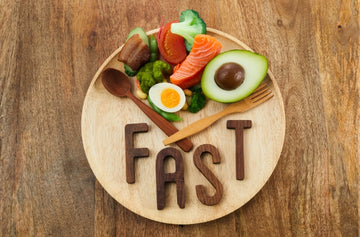Can anti-diabetic drugs help with weight loss?
Have you heard of GLP-1?
When it comes to metabolism, there are many hormones to pay attention to, but one of the most popular nowadays is a hormone called glucagon-like peptide 1, or GLP-1. GLP-1, a hormone released by the small intestine in the presence of nutrients, has important metabolic benefits. The hormone is the target of some of the most popular weight loss and anti-diabetic drugs that are available right now, including the drugs Wegovy and Ozempic.
To understand what the drugs do, it’s crucial to understand what the hormone itself does. GLP-1 inhibits glucagon, which is a hormone that increases blood glucose. Thus, if GLP-1 reduces the amount of glucagon being released, it helps control blood glucose, a huge benefit for T2 diabetics.
People are often quick to point out that GLP-1 can increase insulin, a hormone profoundly important to metabolic health. However, it’s important to note that GLP-1 activation will not always increase insulin. A human can eat pure fat and GLP-1 will go up significantly, and yet insulin won’t budge at all. Thus, while GLP-1 can affect insulin, it does not necessarily do so.
GLP-1 can be sensed by the brain, and when it is, two beneficial things happen: it will induce satiety [1] so a person feels more full and can better moderate diet. At the same time, when GLP-1 is sensed by the brain, it will activate brown adipose tissue [2]. Brown adipose tissue is a fat tissue with a very high metabolic rate. It burns fat and glucose to create heat. Think of brown fat cells as the engine in a car when you’re revving on the gas with your other foot on the clutch. The engine is burning fuel without actually going anywhere. Collectively, this presents a very favorable metabolic scenario.
Now that you understand what the hormone GLP-1 does, let’s discuss what GLP-1 mimicking drugs do.
Semaglutide is the most common GLP-1 mimicking drug (also known as a GLP-1 agonist). Semaglutide has been split up into two doses that the FDA has approved. Ozempic is the lower dose used to target T2 diabetes. It is designed to reduce glucose levels and thereby make the body more insulin sensitive. The higher dose is several times higher than the anti-diabetic version and is called Wegovy. Wegovy is designed to have an anti-obesity effect.
Because these GLP-1 agonists are drugs, not something your body creates on its own, we must appreciate the fact that whenever a substance is put into the body, there will be consequences or side effects. With semaglutide, like with any drug, we must consider if the consequences we want are worth the risks of the consequences we don’t want.
The benefits of GLP-1 activation listed above apply to the GLP-1 agonist drugs, and those benefits are significant. But let’s discuss some of the side effects.
Side effects of semaglutide drugs include but are not limited to [3]:
-
-
- nausea
- vomiting
- diarrhea
- abdominal pain
- constipation
- heartburn
- rapid heartbeat
- rash, itching, and swelling
- vision changes
- fainting or dizziness,
- And more.
-
More serious side effects to watch for include pancreatitis[4] and thyroid tumors [5].
One of the mechanisms whereby this class of drugs improves insulin sensitivity is in the direct effect they have on fat cells. The GLP-1 mimicking drug liraglutide, in specific, has been shown to activate the production of more fat cells (an effect known as hyperplasia)[6]. Liraglutide drugs will stimulate the number of fat cells to increase while also activating enzymes in those fat cells to make them stay small. As long as you’re taking the drug, your fat cells are being told to both shrink and multiply. This does have an overall metabolically favorable effect.
A quick primer on fat cells: fat cells come in two varieties: hypertrophic, which are big, and hyperplastic fat cells, which are generally smaller and more abundant. Hypertrophic fat cells can get insulin resistant and pro-inflammatory. If these hypertrophic fat cells can be shrunk but multiplied, while you’re taking the drug, you’ll have weight loss and an improvement in metabolic health. But fat cells live for roughly ten years. What happens when someone decides they no longer want to be on a drug the rest of their lives? Unfortunately, when people quit these drugs, there are reports of some gaining substantial weight back quickly, and they report gaining even more than they had before [7].
The question, then, is if GLP-1 is so beneficial and you don’t want to have to take a drug that mimics it for the rest of your life, how can you activate this beneficial hormone yourself?
As it so often is, the answer is diet.
A study published back in 1992 compared the effects of the three macronutrients on GLP-1 [8]. When subjects ate pure glucose, GLP-1 went up for a short time and then came very quickly back down. When subjects ate fat, GLP-1 started low and then increased over a longer period of time. Lastly, when subjects ate pure protein, GLP-1 increased and generally stayed up for around three hours.
Additionally, different types of fat have different effects on GLP-1. A peer-reviewed study fed subjects saturated fats in the form of lard, monounsaturated fats in the form of olive oil, and polyunsaturated fats in the form of safflower oil. They then measured the impact of each fat on GLP-1. Notably, the lard and olive oil (saturated and monounsaturated fats) activated GLP-1, while polyunsaturated fats had no effect.
The answer to activating your GLP-1 and receiving the profound metabolic benefits from this hormone is clear: eat your (healthy) fat and protein together, like it’s found in nature.


















 30 Day Money Back Guarantee
30 Day Money Back Guarantee